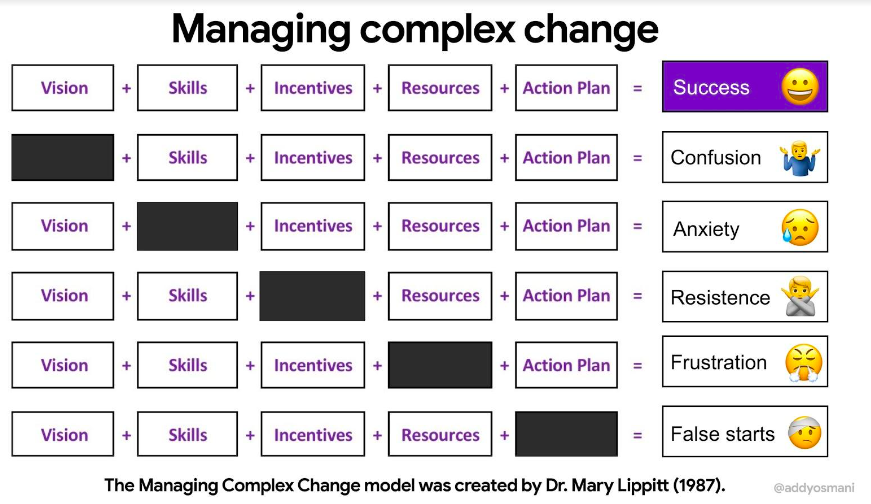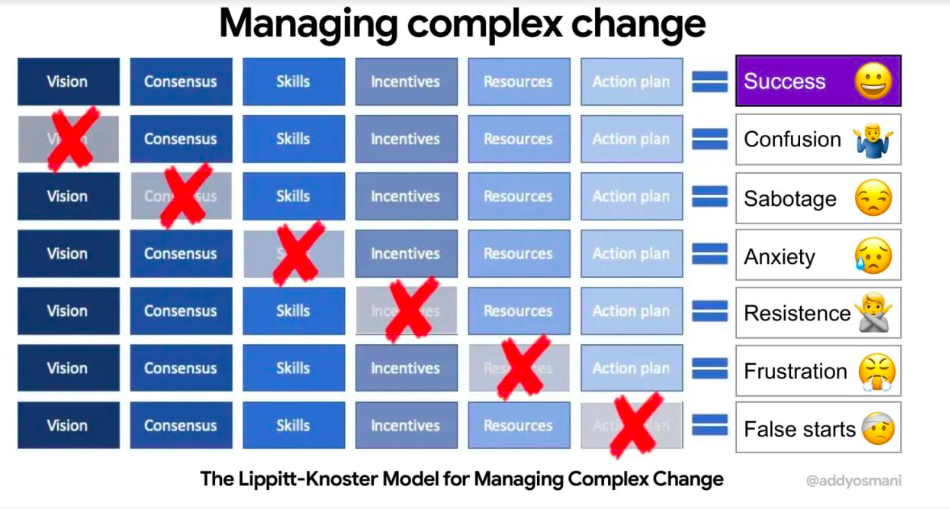You have 1 article left to read this month before you need to register a free LeadDev.com account.
Guiding your team through organizational changes isn’t straightforward. Luckily, there are some ways you may be able to streamline the process.
Software engineering teams benefit from having a plan to manage complex organizational changes. This is because people often don’t like change. In fact, many people often resist or even fear it.
One of the best ways that engineers can help manage this resistance is by clearly communicating with their teams how an organizational change is necessary and in what ways it will benefit everyone involved in the project.
Effective communication of organizational shifts is paramount to help engineers and their teams avoid any confusion or misunderstandings as they work through the process of change.
The Managing Complex Change model
The Managing Complex Change model is an effective framework that can be used to initiate change in any organization. The model was created by Dr. Mary Lippitt, a leadership and management consultant who specializes in helping organizations navigate through change. In this article, we briefly examine each step of the model and how it may apply to your organization’s unique situation.
Here’s the model:

You may also come across another variation of this model, the “Lippitt-Knoster” model, which some would argue includes an additional element. Knoster added the element of ‘consensus’. The thinking here is that there are many cases where leaders can’t assume the success of complex changes without gaining consensus and buy-in from key stakeholders and team members who may be impacted by the changes:

Key aspects to consider in an organizational change
What type of organizational change is considered ‘complex’?
Complex change takes many forms. Often, however, it is a situation where the magnitude of change is high (a large shift in the vision, strategy, or org structure). There may be high levels of uncertainty about the future or several stakeholders with different interests. So, what are the elements that help us navigate such complex changes?
The Managing Complex Change model encourages us to ask:
- What is your vision? Why is a change needed?
- What skills are needed? Does the team have expertise or training in what they are being asked to do? If not, will it be provided by someone they trust?
- What incentives are needed? How will it benefit the team?
- What resources are needed? Are they appropriate? Are there in-house people that can assist with implementation?
- What’s the action plan? What is the timeline? Who is responsible for what? How will progress be measured? What are the follow-up steps if there are problems?
The five-step process
The Managing Complex Change model provides a guide toward asking the correct questions, but it may be difficult for some leaders to harness them into actionable steps.
I have simplified the process into five steps, below.
Step one: What is your vision?
What is your vision? Why is change needed?
You first need to establish your vision and commitment. Determine your clear goals for successful change and communicate them clearly across your organization. A lack of vision can lead to confusion.
When the team asks questions such as, “Why should I do this?” or, “What are they thinking?” they may not realize the overall vision for change. If this isn’t something you can clearly communicate, it’s going to be hard to expect the team to get behind it.
As a reminder, your vision lays out a destination, your destination guides your strategy; strategy chooses action. It’s action that leads to success, a topic we’ll delve into later.
Step two: What skills are needed?
What skills are needed to execute the vision? Does your team have the expertise (or training available) for what they are being asked to do as part of the change? If not, will it be provided? Feeling as if skill or training is lacking may lead to anxiety.
How much time will be required for skill acquisition? Time can be a significant factor in many people’s ability to remain calm during change.
Can you provide the resources needed for self-learning and on-the-job training? Many organizations offer opportunities for employees to improve their knowledge through self-study, reading groups, online courses, and more formal training programs offered by outside sources and institutions.
Step three: What incentives are needed?
The word “incentive” means an action or event that encourages or motivates a person to act in a certain way. Incentives are used by managers when they want employees to change their behavior, for example, when they set up a rewards system at work.
Managers need to think about what reward will be most motivating for employees. It might be something like career progression or a bonus. Or, it could be non-monetary, such as praise from the organization’s leadership. What’s important is understanding the motivation driving each person as it can differ.
Step four: What resources are required?
A lack of resources leaves people frustrated and anxious about their ability to execute on org changes so it is helpful to ask, “What staffing and resources are needed?” This step helps you determine what skills, staff, equipment, and funding you need to address your situation. It helps identify any gaps that may exist between what has been promised and what is actually available.
You can also use this step to help assess whether internal or external support is required for a specific individual or group within the organization.
Step five: What is your action plan?
The final element required for change is an action plan. Once you’ve acquired the necessary resources, you can begin implementing changes that get you closer to achieving your vision successfully and effectively. During this step, it’s important to share progress with all stakeholders so that they stay aligned throughout the process.
“What does success look like?” or, “How will we know when we have reached our goal?” These are questions older than time itself; yet, if not answered correctly, they can lead to years of wasted effort – or worse yet – an entire project being abandoned altogether because it wasn’t clear from the beginning what was being attempted or why.
Reflections
The Managing Complex Change model is a powerful tool for managing and understanding the changes that are happening in your business or organization. It can help you better understand how to manage change and prepare yourself for it.
The model can be applied to any organization or business, regardless of size or industry. The key is to use the model as a way of thinking about change and how people will react to it. By doing so, you will be able to manage change more effectively and improve your ability to innovate.




